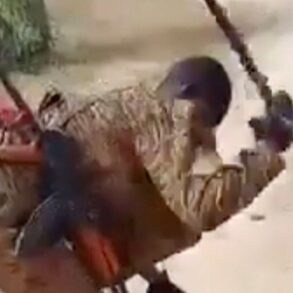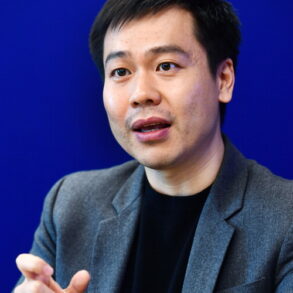Children as young as 15 were repeatedly misidentified as being in their 20s and 30s during government tests of age-checking tools, sowing new doubts about whether the teen social media ban is viable.
ABC News can reveal that face-scanning technology tested on school students this year could only guess their age within an 18-month range in 85 per cent of cases.
“It’s definitely a problem,” said Andrew Hammond, general manager of software consultancy firm KJR, which was tasked with running the trial.
“So far, it’s not perfect, and it’s not getting every child. But does that mean that it’s no good at all?”
Andrew Hammond says the ban can still work despite imperfect technology. (ABC News: Chris Taylor)
The full results of the age assurance technology trial are not expected to be released until later this year, but preliminary data has experts worried.
“I don’t think the ban is viable,” said Lisa Given, professor of information sciences at RMIT University, who has closely analysed the government’s policy.
“Parents are definitely headed for a rude shock, in terms of what this legislation will actually deliver to them.“
Under the social media ban, more than 20 million Australians will be required to demonstrate that they are 16 or older to log in to most major social media platforms.
It is due to take effect in December, but the government is yet to decide how it will be implemented, amid ongoing questions as to whether age-checking technology is up to the job.
The government’s technology trial, which has been running for eight months, was meant to provide some answers, but Professor Given said the public may be disappointed.
Lisa Given says she doesn’t think the ban is viable. (ABC News: Patrick Stone)
“The accuracy level at 85 is actually quite low, and an 18-month range is significant when you’re trying to identify a very particular age grouping,” she said.
“We are going to see a messy situation emerging immediately where people will have what they call false positives, false negatives”.
Some of the students at Canberra’s John Paul College, who previewed the technology as part of the government’s trial, were surprised when their results were up to decades off the mark.
Sixteen-year-old Andy was misidentified as 19, 37, 26, and 23 years old by various face scanning tools he used.
“I don’t think the technology is ready yet to become a full-fledged primary defence system … It’s pretty inconsistent,” he said.
Andy, 16, was identified on one occasion as being 37. (ABC News: Chris Taylor)
Seventeen-year-old Beth was given results ranging from 14 to 32.
“I usually get told by other people that I don’t look 17, I look older. And so when it says 14, I thought … that’s interesting.”
Her results from the other end of the spectrum were unwelcome for different reasons.
“It’s a bit insulting because that’s how old my aunty is … I don’t want to look 32 just yet,” she said.
One tool mistook Beth, 17, as being 32 years old. (ABC News: Chris Taylor)
Seventeen-year-old Nomi was especially concerned when one tool mistook her for a 13-year-old.
“I’m almost 18. If I try to sign up to an app and it tells me ‘you’re not meeting an age requirement’ even though I am, that would be a problem for me,” she said.
Nomi, 17, was mistaken by one tool as being 13. (ABC News: Chris Taylor)
Ban should not depend on face scanning, says industry
While the face scanning results from the trial might not seem promising, Mr Hammond said he is confident the ban will still work because it does not rely exclusively on that tech.
“If the solution to implementing the legislation was just facial age estimation, I’d say ‘yep, it’s probably not good enough’,” he said.
“However, it’s just one of the tools in the toolkit that could be used.”
Age verification providers are not discouraged by the early results either, arguing that other tech was always going to be necessary as a complement to get precise results.
“You would never rely on age estimation for people who are literally at the age of 16,” said Iain Corby from the Age Verification Providers Association, the industry body for age-check companies.
“It was never going to be good enough for that,”
he said.
Mr Corby said the early data reported by ABC News (showing an accuracy rate within 18 months for only 85 per cent of students) is roughly what he expected.
“I think even the best-in-class achieves about a year and a month, on average, above or below your real age.”
Facial age-estimation is just one kind of technology that may be used to implement the ban. (ABC News: Steven Byers)
Among the methods tested were other age-estimation techniques that rely on biological traits such as voice and hand movements to guess the age of a user.
But those methods struggle with the same accuracy issues, and fewer companies offer the service.
Another avenue is guessing a person’s age based on their online activity, but that is also imprecise.
Other tools offer a higher degree of certainty by inferring or even verifying a user’s age, using data provided by third parties such as banks, schools, or healthcare providers.
The strongest proof is a government-issued ID, such as a passport or a driver’s license, but the legislation prevents social media companies from insisting on it.
A last-minute amendment to the bill, when it was passed back in November, means platforms will be forced to offer users alternative methods to prove their age.
That rule means many Australians who cannot easily provide those more reliable proofs may be forced to rely on less accurate methods, such as face scanning, if they want to use social media.
A last-minute amendment to the bill will force platforms to offer users alternative methods to prove their age. (ABC Graphics: Sharon Gordon)
“We do know generally that young people are going to be less likely to have a government-issued ID that would satisfy some form of age verification,” said Professor Given.
If facial scanning is on offer, under-16s who want to dodge the ban might be tempted to choose it anyway, in the hope they can fool it.
“They might put glasses on, they might put makeup on, different hairstyle, different lighting, just to see if the system is actually able to accurately see that they’re underage or over 16,” said Professor Given.
How the ban could solve for face scanning inaccuracy
The government is expected to decide how the ban will work in the coming months, but one possible solution for the shakiness of facial scanning is a cascade-style system, similar to what we see in bottle shops.
Users might use face scanning tech as a first hurdle, and only be asked for further proof if their result is within a five or 10-year margin of 16.
“If you’re within that margin for error, then you have to go to a second stage and find some other way of confirming that somebody is over the legal age,” said Mr Corby
Even so, everyone agrees it will not be perfect.
“I’m optimistic, having seen the results,” said Mr Hammond.
“Not necessarily making sure every 16-year-old doesn’t get access, but making sure that most 16-year-olds don’t get access to social media.
“There’s a number of solutions … and they have a level of accuracy. Now, whether the accuracy is good enough is a different question.”
Andrew Hammond works for software consultancy firm KJR, which ran the trials. (ABC News: Steven Byers)
Professor Given sees the end of the tech trial as an opportunity to reconsider the ban.
“A responsible decision from government would be weighing up the evidence in front of them and deciding whether that’s actually a robust approach,” she said.
In the meantime, public expectations of the policy remain undeterred.
“I think it’s a really positive move for our young people,” said the principal of John Paul College, Craig Wattam.
“I think that limiting their exposure to places that are potentially really dangerous is a really liberating thing,” he said.
Craig Wattam is also hopeful the kinks in the tech can be ironed out. (Supplied)
On the question of the tech’s accuracy, he is also an optimist.
“I guess this is the whole purpose of a trial,” he said.
“I’m confident that by the time we get closer to December … they may well have figured out more accurate ways to verify students’ ages.“
A spokesperson for Communications Minister Anika Wells told ABC News the government would be guided by advice from the eSafety Commissioner on how best to implement the ban.
“We know that social media age-restrictions will not be the end-all be-all solution for harms experienced by young people online, but it’s a step in the right direction to keep our kids safer,” they said.
This post was originally published on this site be sure to check out more of their content







